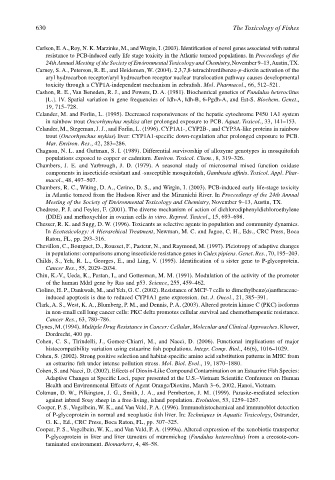Page 650 - The Toxicology of Fishes
P. 650
630 The Toxicology of Fishes
Carlson, E. A., Roy, N. K. Marzinke, M., and Wirgin, I. (2003). Identification of novel genes associated with natural
resistance to PCB-induced early life stage toxicity in the Atlantic tomcod populations. In Proceedings of the
24th Annual Meeting of the Society of Environmental Toxicology and Chemistry, November 9–13, Austin, TX.
Carney, S. A., Peterson, R. E., and Heidemen, W. (2004). 2,3,7,8-tetrachlrordibenzo-p-dioxin activation of the
aryl hydrocarbon receptor/aryl hydrocarbon receptor nuclear translocation pathway causes developmental
toxicity through a CYP1A-independent mechanism in zebrafish. Mol. Pharmacol., 66, 512–521.
Cashon, R. E., Van Beneden, R. J., and Powers, D. A. (1981). Biochemical genetics of Fundulus heteroclitus
[L.]. IV. Spatial variation in gene frequencies of Idh-A, Idh-B, 6-Pgdh-A, and Est-S. Biochem. Genet.,
19, 715–728.
Celander, M. and Forlin, L. (1995). Decreased responsiveness of the hepatic cytochrome P450 1A1 system
in rainbow trout Oncorhynchus mykiss after prolonged exposure to PCB. Aquat. Toxicol., 33, 141–153.
Celander, M., Stegeman, J. J., and Forlin, L. (1996). CYP1A1-, CYP2B-, and CYP3A-like proteins in rainbow
trout (Oncorhynchus mykiss) liver: CYP1A1-specific down-regulation after prolonged exposure to PCB.
Mar. Environ. Res., 42, 283–286.
Chagnon, N. L. and Guttman, S. I. (1989). Differential survivorship of allozyme genotypes in mosquitofish
populations exposed to copper or cadmium. Environ. Toxicol. Chem., 8, 319–326.
Chambers, J. E. and Yarbrough, J. D. (1979). A seasonal study of microsomal mixed function oxidase
components in insecticide-resistant and -susceptible mosquitofish, Gambusia affinis. Toxicol. Appl. Phar-
macol., 48, 497–507.
Chambers, R. C., Witing, D. A., Cerino, D. S., and Wirgin, I. (2003). PCB-induced early life-stage toxicity
in Atlantic tomcod from the Hudson River and the Miramichi River. In Proceedings of the 24th Annual
Meeting of the Society of Environmental Toxicology and Chemistry, November 9–13, Austin, TX.
Chedrese, P. J. and Feyles, F. (2001). The diverse mechanism of action of dichlorodiphenyldichloroethylene
(DDE) and methoxychlor in ovarian cells in vitro. Reprod. Toxicol., 15, 693–698.
Chesser, R. K. and Sugg, D. W. (1996). Toxicants as selective agents in population and community dynamics.
In Ecotoxicology: A Hierarchical Treatment, Newman, M. C. and Jagoe, C. H., Eds., CRC Press, Boca
Raton, FL, pp. 293–316.
Chevillon, C., Bourguet, D., Rousset, F., Pasteur, N., and Raymond, M. (1997). Pleiotropy of adaptive changes
in populations: comparisons among insecticide resistance genes in Culex pipiens. Genet. Res., 70, 195–203.
Childs, S., Yeh, R. L., Georges, E., and Ling, V. (1995). Identification of a sister gene to P-glycoprotein.
Cancer Res., 55, 2029–2034.
Chin, K.-V., Ueda, K., Pastan, I., and Gottesman, M. M. (1991). Modulation of the activity of the promoter
of the human MdrI gene by Ras and p53. Science, 255, 459–462.
Ciolino, H. P., Dankwah, M., and Yeh, G. C. (2002). Resistance of MCF-7 cells to dimethylbenz(a)anthracene-
induced apoptosis is due to reduced CYP1A1 gene expression. Int. J. Oncol., 21, 385–391.
Clark, A. S., West, K. A., Blumberg, P. M., and Dennis, P. A. (2003). Altered protein kinase C (PKC) isoforms
in non-small cell lung cancer cells: PKC delta promotes cellular survival and chemotherapeutic resistance.
Cancer Res., 63, 780–786.
Clynes, M. (1994). Multiple Drug Resistance in Cancer: Cellular, Molecular and Clinical Approaches. Kluwer,
Dordrecht, 400 pp.
Cohen, C. S., Tirindelli, J., Gomez-Chiarri, M., and Nacci, D. (2006). Functional implications of major
histocompatibility variation using estuarine fish populations. Integr. Comp. Biol., 46(6), 1016–1029.
Cohen, S. (2002). Strong positive selection and habitat-specific amino acid substitution patterns in MHC from
an estuarine fish under intense pollution stress. Mol. Biol. Evol., 19, 1870–1880.
Cohen, S. and Nacci, D. (2002). Effects of Dioxin-Like Compound Contamination on an Estuarine Fish Species:
Adaptive Changes at Specific Loci, paper presented at the U.S.–Vietnam Scientific Conference on Human
Health and Environmental Effects of Agent Orange/Dioxins, March 3–6, 2002, Hanoi, Vietnam.
Coltman, D. W., Pilkington, J. G., Smith, J. A., and Pemberton, J. M. (1999). Parasite-mediated selection
against inbred Soay sheep in a free-living, island population. Evolution, 53, 1259–1267.
Cooper, P. S., Vogelbein, W. K., and Van Veld, P. A. (1996). Immunohistochemical and immunoblot detection
of P-glycoprotein in normal and neoplastic fish liver. In: Techniques in Aquatic Toxicology, Ostrander,
G. K., Ed., CRC Press, Boca Raton, FL, pp. 307–325.
Cooper, P. S., Vogelbein, W. K., and Van Veld, P. A. (1999a). Altered expression of the xenobiotic transporter
P-glycoprotein in liver and liver tumours of mummichog (Fundulus heteroclitus) from a creosote-con-
taminated environment. Biomarkers, 4, 48–58.

